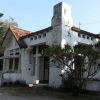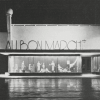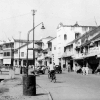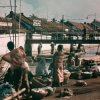
From 1947 onwards a number of houses on Laan Wiechert (now Jalan Kramat VII) were occupied by Moluccan/Maluku families. And even today there is a lively Moluccan community in the area. Following the events of Indonesia’s independence in August 1945, many residents from predominantly Christian districts in Indonesia, like Minahasa (North Celebes/Sulawesi), Timor and Ambon, who were traditionally well represented in the Dutch East Indies Army (KNIL) were accused of ‘sympathising’ with the Dutch during the bersiap years (1945-1949). Many of them felt unsafe in Jakarta and were threatened and bullied by local residents. After a Moluccan family was terribly killed in Jatinegara and thrown into a well, an estimated 120 Moluccan families fled to Kramat.
Japanese internment camp
As the side streets of Kramat had been part of a Japanese internment camp during World War II, the streets were still partly fenced off and secluded, hence many felt safe to gather in this area. The community installed guards and built the Eben Haezer Church on Jalan Kramat VII in 1948, which still stands today. Following the events of the declaration of the Republik Maluku Selatan (RMS) in 1950, the Kramat area was the scene of many Moluccan protests and gatherings, like on this picture from November 1950taken in front of the house on Jalan Kramat VII 23. The name Jalan Kramat VII was only given to the street around 1960.
Name changes
Following the mass change of street names in independent Djakarta in July 1950, Laan Wiechert changed into Djalan Sofir. Also Jalan Kramat V had an intermediate name: Kramatlaan changed into Djalan Mutiara in July 1950, before it obtained its current name 10 years later.
sources: Google, Moluks Historisch Museum, BBC Indonesia





